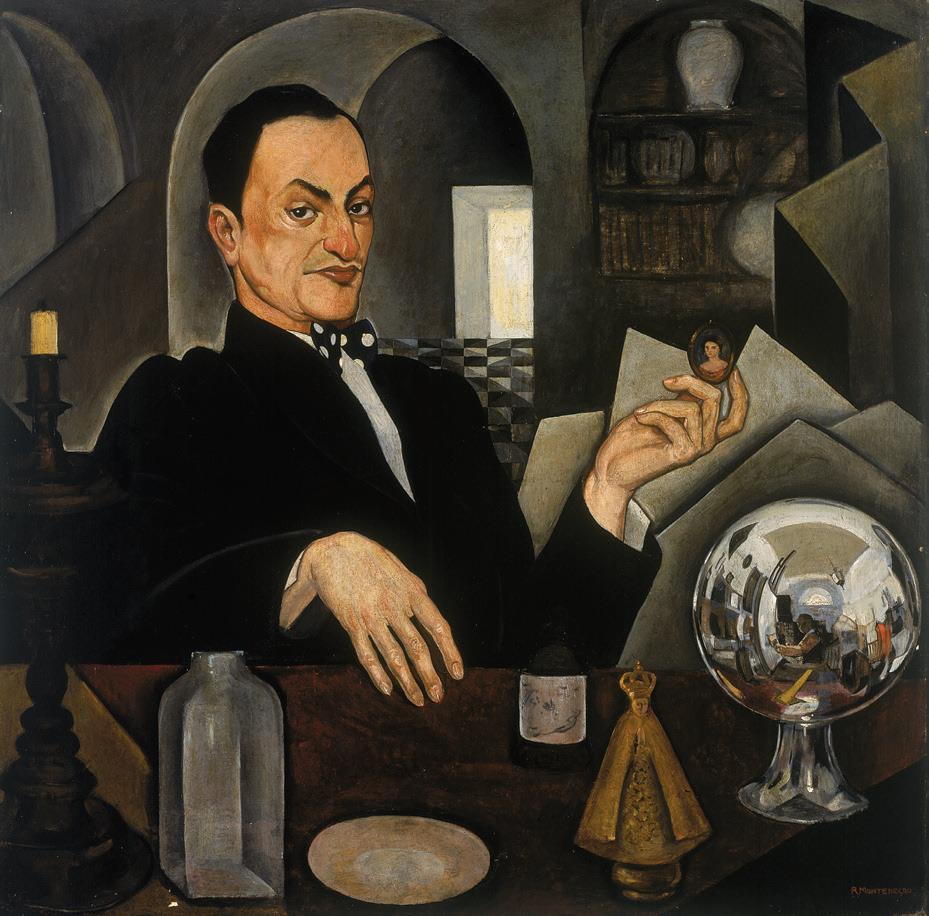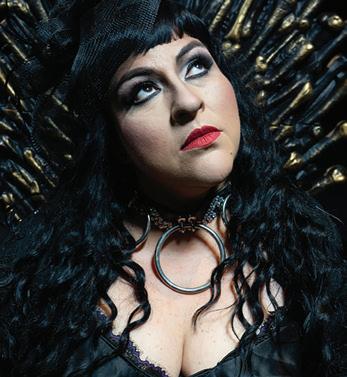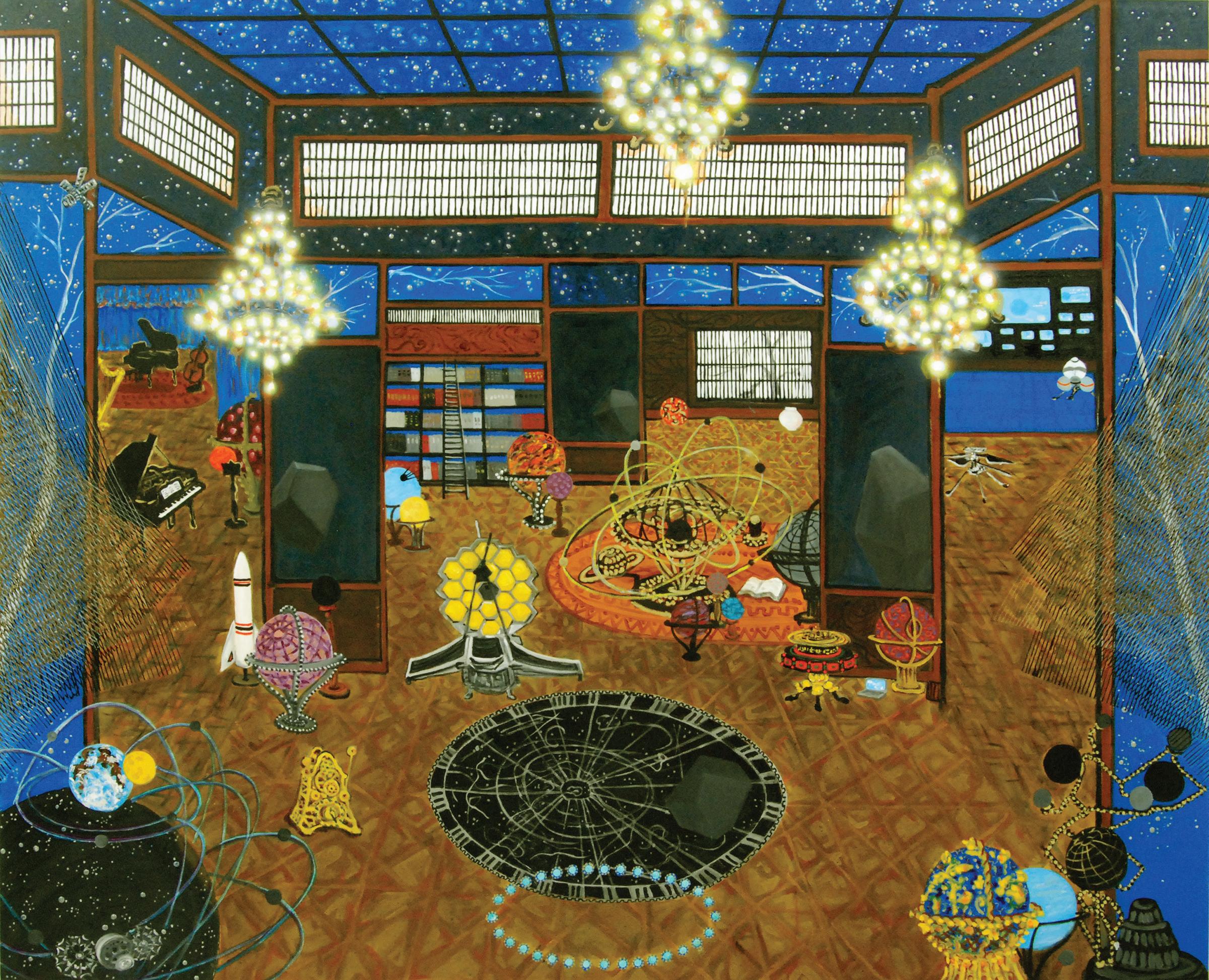
7 minute read
Witch Season Karla Galván calls on old friends for her newest show at Teatro Tariakuri.
FALL THEATER THEATER & ARTS& ARTS
DESTINOS FESTIVAL HIGHLIGHT
Advertisement
Season of the witch
Karla Galván calls on old friends for her newest show at Teatro Tariakuri.
By JACK HELBIG
Karla Galván fell in love with performing when she was fi ve, appearing in a public celebration of a Mother’s Day performance her mother had put together. “She’s like, ‘OK, mija, you’re going to dance,’” Galván remembers. “And so I danced to this song and I’ll never forget the adrenaline of the nerves going on stage, the nerves backstage, when you’re like, ‘Oh, it’s almost my turn.’ And then you cross that threshold. The stage back then looked huge with a full house of parents and students, and all these eyes were on me.”
Her love of performing flowered at Carl Schurz High School, where she was part of the drama and speech team. “We were the only school [in the speech competitions] that had Latinos on their teams.” But her dreams were almost dashed by the cost of being a theater student at Columbia College. “‘You know what?’” Galván recalls her mother telling her. “‘I can’t afford to pay that. That’s way too much.’”
But her mother had a solution. Galván recalls her mother’s words: “‘What I can do is, I can send you to Mexico and learn as much as you can in Mexico City.’” Galván then adds, “My mom found a school in Mexico City and she said, ‘You know what? I’m going to send you there for a year.’”
She studied Method acting with Mexican actress Natalia Traven, a veteran of both the Mexican film industry and Hollywood. (She says that. But there is meaning behind that word.”
She named her theater in part in honor of one of her mother’s favorite performers, the Mexican singer Amalia Mendoza, nicknamed “La Tariácuri.” Mendoza, who died in 2001, was known for her highly emotional renditions of rancheras and boleros. She often cried as she sang. Galván jokes that her mother always said she was “a crybaby, too”— so much so that her mother jokingly compared her to Mendoza. But Tariakuri has another meaning. Tariácuri was also the leader of the Purépecha people, one of the last Indigenous tribes in Mexico. Galván is Peruvian and Mexican; the name Tariakuri honors her Mexican roots. Tariakuri opened its first doors on 18th Street “right off Ashland” in Pilsen in 2004, and Galván produced shows there for four years. Her focus was on performing shows in Spanish by Mexican playwrights. She also favored doing comic plays with a family
most recently appeared as a leading character in Clint Eastwood’s 2021 fi lm Cry Macho.) “I was fortunate,” Galván says. “Natalia Traven is a very important person to me because she’s the one that actually took her love and emotion and informed me as a creator.”
Galván returned to Chicago to break into the theater scene. “Every time I would go and audition, I would always get, ‘You sound great, but we need more Caucasian.’ I’ve literally been told that ‘You need to work on your accent.’ If I get cast, I am the maid, or I am the ex-con, and I would think, ‘Wait a minute. I know MeisBRUNA LA BRUJA BRUTA 9/17-10/16: Sat 8 PM, Sun 7 PM, Teatro Tariakuri, 3117 ner technique. I have learned W. 63rd, teatrotariakuri. Strasberg!’” org, $35
Finally, Galván reached the conclusion that the only way she was going to get work was if she started her own theater company.
“I was young, and stupid, and naive,” Galván laughs, “I was 24, 25.” She started her company in 2003 and decided on the name Tariakuri. “Yes,” Galván laughs. “Tariakuri is di cult to pronounce. I get it. And even my own husband
WRIGHTWOOD
CHICAGO
THE FIRST
GLOBAL DEPICTIONS OF A NEW IDENTITY 1869-1930
A revealing look at same-sex desire.
The word “homosexual” was coined in Europe in 1869—unleashing stunning depictions of same-sex desire in the visual arts world. Discover how artists across five continents expressed queer identity in this pioneering survey of paintings, drawings, prints, photographs, film clips, and many national treasures—from public and private collections around the globe.
PLEASE NOTE: The First Homosexuals contains sexually explicit content. For mature audiences only.
IMAGE CREDITS: Roberto Montenegro, Retrato de un anticuario o Retrato de Chucho Reyes y autorretrato, 1926, oil on canvas, 102.5 x 102.5 cm, Colección Pérez Simón, Mexico. (Detail)
SUPPORT FOR THESE EXHIBITIONS IS PROVIDED BY ALPHAWOOD FOUNDATION CHICAGO

Karla Galván HÉCTOR IVÁN GARCÍA
appeal. “It is teatro pelado and carpa,” she explains. “It has a slapstick, raw quality.”
One of her first shows was Drácula Gay, an extended comic monologue by Mexican playwright Tomás Urtusástegui about a gay vampire talking about how he got his fangs out. She produced another show based on the music of the popular writer and performer of children’s songs, Francisco Gabilondo Soler, and a play about traveling theater troupes in Mexico, Tiempos de Carpa by Manuel Bauche Alcalde.
But the rising costs associated with the gentrification of Pilsen made it harder for businesses like hers to stay open. “I couldn’t keep afl oat,” she says sadly. “It was heartbreaking. I was so upset. You close your business, your baby.”
After her fi rst venue closed, Galván says, “I just got a regular job and was miserable for seven years. I was a medical biller, working collecting debts from patients. And then I also managed a dollar store. It wasn’t pretty.”
During this same time her husband, who was undocumented, returned to his home country, Mexico, so he could apply to be a documented immigrant. Galván was left alone, working part-time in a hospital, living o of savings, and taking care of her infant daughter. And feeling herself slip into depression. “I called a good friend of mine, Javier Salas, and I said, ‘Javier, please tell me you have something for me. Anything, please. I need to do something. Is there any production going on?’”
Salas was doing a play, Las Vírgenes prudentes by Jesús Cotta, and he needed to cast the lead.
“And that’s when it all started again for me,” Galván enthuses. She revived her theater, moved into a storefront in Marquette Park, and then . . . “I started producing, producing, producing. I’ve done so many productions I already thought about. I redid a lot of my productions, a lot of everything, and I haven’t stopped since then.”
Her current production is a solo piece, Bruna la Bruja Bruta (which Galván translates as Bruna the Stupid Witch). It’s being presented as part of Destinos, the fi fth Chicago International Latino Theater Festival, produced by the Chicago Latino Theater Alliance (CLATA). Galván stars as Bruna—“I haven’t been on stage with a main character in ten years”—and is being directed by Traven, her old acting teacher from Mexico City. The play was written by Galván’s old friend Urtusástegui. “I went to [Traven],” Galván explains. “Not only because she’s such a good director, and she’s a good teacher; I needed somebody that still has that sparkle of true Mexico because she lives there [in Mexico City].”
“Bruna is a single mom. She talks about being a single mom, and her three little witches, and how she survived with her three little witches. We’re talking about a witch that’s lived more than 200 years, so long that she has seen everything that’s going on in the world— feminism, machismo, Salem and the witches. And it does it all with comedy. I want to say it’s similar to John Leguizamo’s Latin History for
FALL THEATER THEATER & ARTS& ARTS
Morons.”
Galván did much of her rehearsing with Traven in Mexico City. “I just came back from Mexico a week ago, and it is very humbling. [As a Mexican American] I am so different from [Mexicans]. I know I am a breed of my own in the United States. It’s really weird. Here, we are welcomed, but not welcomed. And in Mexico, we’re welcome, but we’re not welcome. So we’re right there on the border. It is a very difficult [balance], but you know what? I survived it. I’m still surviving it.” v @JackHelbig
WRIGHTWOOD
CHICAGO

Explore mysterious portals to the unknown.
Michiko Itatani has grappled with the mysteries of the universe in her work throughout her prolific career. This exhibition of 50 works celebrates the Chicago-based, American artist’s determination to “know the unknown.” Spanning two floors and myriad decades, the exhibition includes breathtaking, never-before-seen works.
IMAGE CREDITS:“Collection Sol III” painting from Celestial Maze 22-B-1, Michiko Itatani, 2022, 78” x 96,” oil on canvas, courtesy of Michiko Itatani. (Detail)
SUPPORT FOR THESE EXHIBITIONS IS PROVIDED BY ALPHAWOOD FOUNDATION CHICAGO










